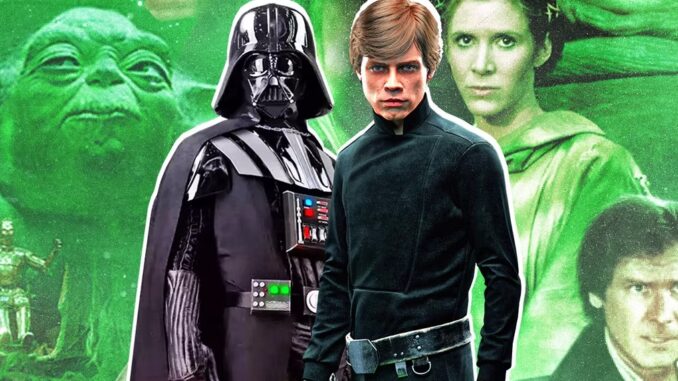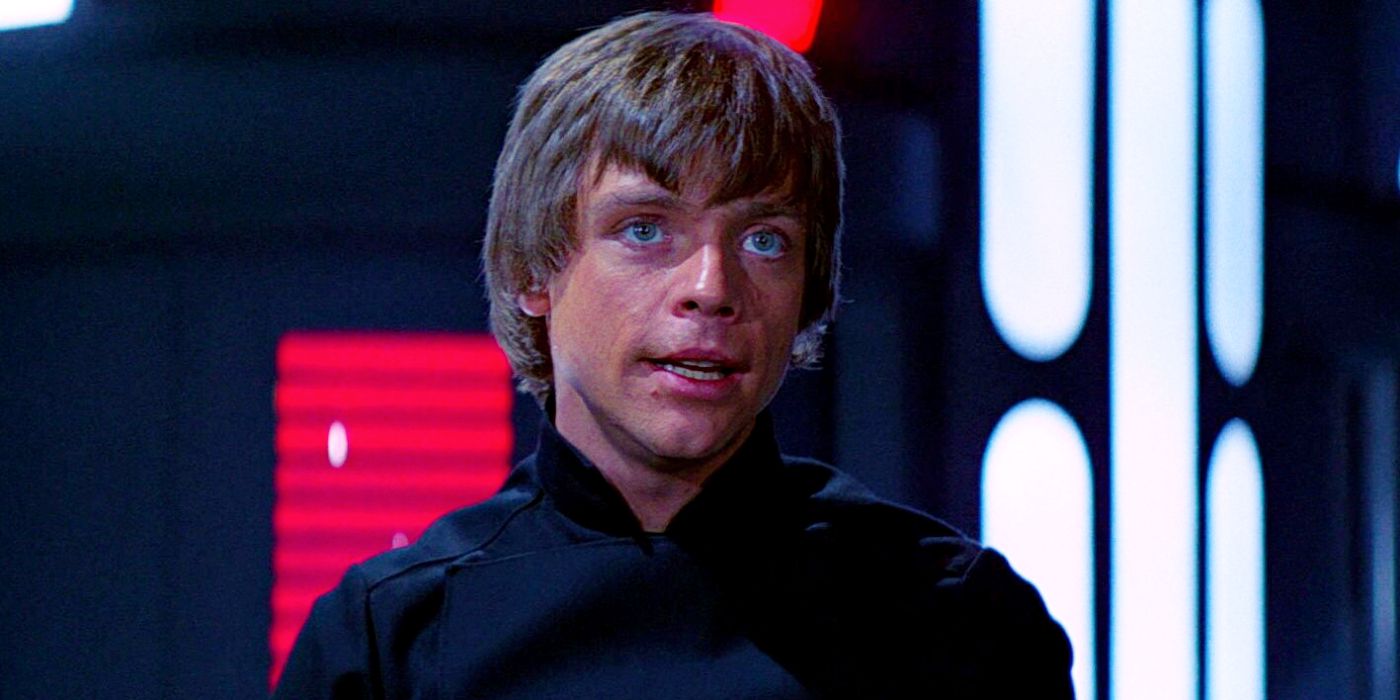
One Star Wars Deleted Scene Completely Changes Return of the Jedi
Star Wars: Return of the Jedi is a classic film, but one deleted scene with Luke and Darth Vader could have changed how the movie went.

Return of the Jedi was the final film in the original Star Wars trilogy. The ideas and iconic characters that it introduced stayed with the franchise for years to come. The plot brought a significant victory for Luke, Leia, Han and the light side of the Force. It also ushered in the death of Vader and the defeat of Emperor Palpatine (though his consciousness survived his significant fall at the end of Episode VI). Indeed, the entire saga pivots on the film’s climax, with the destruction of the millennia-old Republic complete and the galaxy struggling to build something new from the ashes of the Empire that replaced it.
Like most films, however, not every scene made it into the final cut. While some of these scenes proved to be inconsequential to Return of the Jedi’s plot, others could have profoundly impacted the entire film. One example of the latter is the film’s deleted scene, “Vader’s Arrival and Reaching Out to Luke,” which can be found on Disney+. Not only does it expand and enhance their story, but it changes the entire nature of the film: revealing key themes earlier and shifting the narrative dynamic in subtle but telling ways.
A collage of poster art from the Star Wars Original Trilogy and the Sequel Trilogy
Why Star Wars’ Original Trilogy Heroes Had to Fail In the Sequels
Star Wars fans were disappointed the heroes of the original trilogy failed in the sequel movies, but they had to maintain a crucial narrative theme.
The Extra Scene Establishes Vader’s and Luke’s Force Connection Significantly Earlier
Luke Skywalker and R2-D2 in Star Wars: Return of the Jedi deleted scene
The Rancor about to be crushed by a gate in Star Wars Episode 6: Return of the Jedi
Return of the Jedi’s Most Heartbreaking Scene Just Became Even More Devastating
Saladin Ahmed’s “The Plan” explores Malakili and Pateesa’s bond, making Pateesa’s death even more heartbreaking in Star Wars: Return of the Jedi.
The scene opens with Darth Vader and an Imperial Admiral talking to one another. Vader chastises his lack of competence and reminds him that their failures and lack of progress won’t spare them from the wrath of the powerful Emperor, who was on his way to see them. The scene then cuts to Darth Vader sitting in his chamber, as seen in TheEmpire Strikes Back, where he tries calling Luke Skywalker through the Force. If this scene had been included in the movie, it would have established Luke and Vader’s connection through the Force over an hour before the audience learned of it in the final cut.
The scene continues on to Luke, who is sitting in a cave on Tatooine and working on his new lightsaber. This would have marked the first time a lightsaber was being built on screen. Rather than answer Vader, Luke looks to R2-D2 in front of him and ignites his new green blade. He reaches up to touch a spot on R2 where he will store the saber for their plan to rescue Han Solo from Jabba the Hutt. The scene has no dialogue but does an excellent job of foreshadowing the plan that will come later in Return of the Jedi, where Luke surrenders himself to Vader in order to avoid revealing the location of the Rebel strike force on Endor. That same scene would also reveal the Emperor planned to replace Vader with Luke as his loyal right hand.
In the deleted scene, C-3PO waits outside of the cave, unaware of the intricacies of the plan. He is kept in the dark for the rest of the rescue, which is probably for the best, since he might have blown their cover. Nevertheless, the most notable part of the shot is actually the Millennium Falcon and X-Wing parked in the background. The only dialogue is Threepio’s: bemoaning the desolate environment of Tatooine and delivering his signature line, “we’re doomed,” as he and R2-D2 head towards Jabba’s palace. Once again, without using words, the scene shows the viewer that Han’s rescue was planned well in advance, and Lando, Leia, and Chewie’s roles were all carefully laid out. The fact two vehicles instead of just one sit nearby prove that Luke is not alone, and that his efforts are part of a coordinated group effort.
In the theatrical release of Return of the Jedi, the parallels between the first and third movies are evident: mainly with the two droids walking in a desolate desert and quietly bickering with each other. However, what makes this film stand apart from the others is the profound change in Luke Skywalker. Before, he was just a farm boy who longed for adventure. By the time he returns to rescue Han, he is a much more mysterious character who’s nursing psychological wounds. Though on the cusp of becoming a Jedi, Luke has paid a grievous price for it, including the loss of his hand. Additionally, Luke’s visibly troubled by his connection to Vader and isn’t prepared to accept him as his father. However, Luke wears all black, a color usually associated with the
Dark Side and suggesting that he’s closer to embracing it than he has ever been before. This additional tease of his potential turn to evil would have been a great addition to the beginning of the film.
Return of the Jedi Featured the Development of Luke Skywalker’s Character
Star Wars: Return of the Jedi Inspired Key Deadpool 3 Scene, Director Reveals
Deadpool 3 director Shawn Levy explains the influence Star Wars: Return of the Jedi had on his movie.
More importantly, the scene would’ve informed later entries in the Skywalker Saga as other Force wielders appeared on the scene and engaged in similar struggles of the soul. That starts with Luke’s nephew Ben, who falls to the Dark Side during the sequel trilogy, only to be redeemed with help from his “Force twin” Rey in The Rise of Skywalker. While she doesn’t fall to the Dark Side, Ahsoka Tano faces her own capacity for evil during her spiritual confrontation with Anakin in Ahsoka Season 1, Episode 5, “Shadow Warrior.” Similarly, her erstwhile foe Baylan Skoll is a fallen Jedi, but seeks a different path than the pure evil of the Sith. Meanwhile, Reva Sevander — Vader’s sinister minion in the Obi-Wan Kenobi miniseries — throws off the Dark Side when she’s unable to kill a young Luke in the final episode.
These examples have enriched the concept of the Force and how inhabitants of the Star Wars universe navigate its spiritual potential. Things looked a lot more black and white in the early days of the saga, and Obi-Wan’s notion that ethics depend on “a certain point of view” didn’t have many concrete examples. Luke’s near-miss with the Dark Side is sufficiently fleshed out in Return of the Jedi and doesn’t require any further exposition, but as the saga has grown, so too have the dramatic opportunities to explore that equation. The cut scene feeds into that impression, and lends insight into how powerful the Dark Side can be sometimes. In retrospect, including it in Return of the Jedi would have better established that notion for the franchise to take better advantage of later.
Of course, once the group rescues Han, it is confirmed that Luke chose the light side of the Force, furthered his Jedi training, and is more skilled than ever before. The reason for his black attire has been up for speculation for a long time, and remains unconfirmed as of this writing. Some believe that he was mourning the Jedi who fell decades prior or that it symbolized his growing connection to the Dark Side. Alternatively, perhaps the creators were deliberately trying to trick the audience into thinking Luke had turned. Whatever the reason, Luke’s loyalty to the light is symbolized in his clothing at the end of Return of the Jedi, when his tunic is partially pulled back to reveal white underneath the black. The deleted scene set up many themes that helped bolster the connections established in the film. Sadly, the scene was cut for time and to improve the pacing. Even so, the moment was not completely lost since Luke’s lightsaber construction scene was canonized in the novelization, Return of the Jedi: Beware the Power of the Dark Side. It’s impossible to know how the deleted scene’s inclusion might have changed the rest of the Star Wars canon, but its deeper themes might have changed the movie completely if it had stayed.
